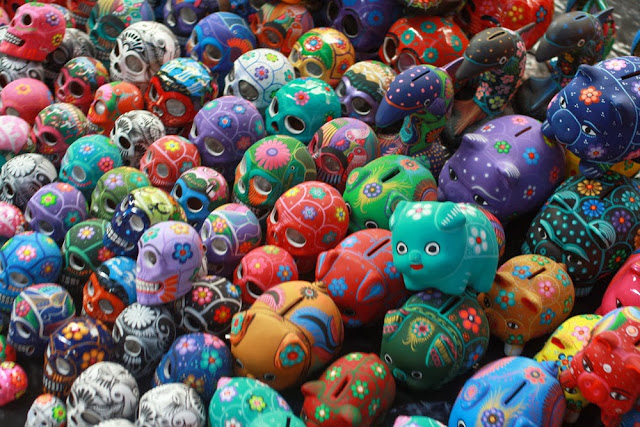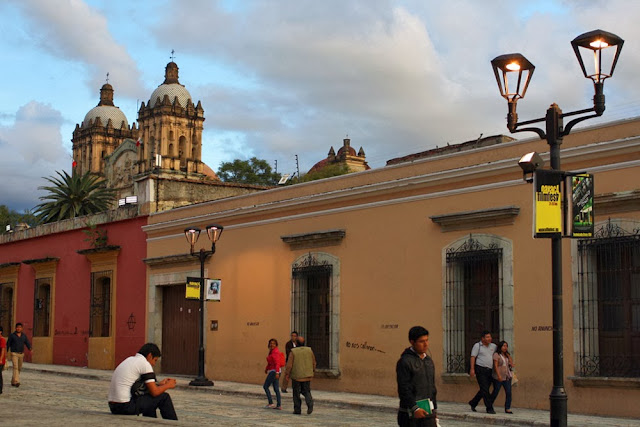Start from the beginning of our Mexico trip.
After a week in Mexico City, we packed up for Oaxaca, six hours southeast from Mexico City by bus. We had chosen Oaxaca for its mountainous landscape, colonial architecture, indigenous traditions and its reputation for some of the best food in the country.
Oaxaca's valleys have long served as an important center for indigenous tribes, including the Zapotecs and Mixtecs, who remain the two main ethnic groups in Oaxaca today. Each of the three central valleys offers its own distinctive mix of archaeological sites and villages, many of which specialize in a particular handicraft. They're popular day trips from Oaxaca, especially on market days, when thousands of people converge to buy, sell and socialize at open-air markets called tianguis that date to pre-Hispanic times. Our first day in town we headed to the tianguis in the village of Tlacolula.
Arriving at the market was a typically Latin American adventure. We walked to the second-class bus station, where we hailed a taxi, who tried to charge us double what it should have cost. We haggled it down and got in, at which point we discovered this was less of a true taxi service and more of a colectivo, where the driver tried to pick up more passengers by yelling and honking at everyone he saw. Only once he had a full car with three people squished front and back did he start driving with any speed toward Tlacolula. We didn't understand the economics behind the driver's pricing because he made at most 100 pesos from the trip and spent a lot of time trying to find additional riders. Yet to drive us directly to Tlacolula, he wanted 160 pesos. The ride was a bit harrowing with no seat belts and all of the drivers treating a one-lane road as two lanes, but we made it.
We wandered around the market, which sold everything from live chickens to tchotchkes (I had no idea how to spell that word) before hopping in two more taxis to reach the weaving town of Teotitlán del Valle. The weaving tradition there dates back to pre-Hispanic times when Teotitlán had to pay tributes of cloth to the Aztecs. Today roughly 150 families in the village specialize in weaving and some still use traditional dyes made from indigo, cochineal and moss. Several of the weavers demonstrated their technique on hand looms and we came home with a new bathroom set. [1]
Thanks to the generally inefficient local transport, we ended up walking four kilometers back to the main highway. We didn't mind the walk though, because we got some beautiful views.
The next day we explored the ruins at Monte Alban. To learn more about Oaxaca's most famous culinary creation, we took a cooking class where we learned to cook mole. We followed that up with two days of hiking in the Sierra Norte, before two final days in Oaxaca.
Photos: Oaxaca at night
The Spanish founded the city of Oaxaca in 1529, deriving its name from the existing Aztec settlement of Huaxyácac (meaning "In the Nose of the Squash"). Laid out on a grid, it is a classic example of sixteenth-century colonial urban planning, with the central square as the economic, religious and social heart of the city. Plagued by earthquakes, the city developed its own unique style of colonial architecture, characterized by thick walls and low buildings. [2]
The region is also the birthplace of two of Mexico's most famous figures: hero Benito Juarez, a reformer who served five terms as president in the 1800s; and villain Porfirio Diaz, the dictator overthrown in the Mexican Revolution.
Most evenings, we enjoyed typical Oaxacan food for dinner and then wandered around the town. The zocalo was teeming with people until about 11 p.m. each night, with several musical acts playing at the same time, including roving mariachi bands. To escape the rain one night, we bought a cup of tea and listened to a good Spanish guitar duo.
By this time, we had been traveling for nearly two weeks, so we took it slow as we explored the city. We bought a hammock and some of Oaxaca's famous chocolate (meant for mole or hot chocolate, not for eating). We browsed the large food markets and purchased avocado leaves (an ingredient in mole, in case we ever decide to make it ourselves) and saffron (much cheaper in Mexico than in the U.S.).
Oaxaca hosts an annual film festival, which happened to be going on while we were there. We saw The Red Robin, a psychological thriller made in the U.S. (all films in the festival had to offer English or Spanish subtitles), which we both hated, though it won awards in screenwriting and cinematography.
 |
| Oaxaca's bell towers are squat with wide bases to protect against the frequent earthquakes. |
 |
| View of botanical gardens as a storm moves in. We kept dry inside the museum. |
We splurged more on food in Oaxaca than we had in Mexico City. The modern Los Danzantes stuck out for its interior decor — it's an open-air space with half of the floor space taken up by a pool, which catches the rain during a storm. It's a very peaceful effect at night. Our last night, we ate at Casa Oaxaca, with the most comically overbearing waiters. Not only did they pull your chair out for you and put your napkin in your lap (including when you returned from the bathroom), but they materialized every few minutes trying to whisk away your dishes or pour you more water. Eventually we tried to tell them to leave us alone for 10 minutes between dinner and dessert so we could finish our sangria and talk without interruption — this was a hopeless strategy because we simply got interrupted by more people, each of whom we had to tell to leave us alone.
My feelings about restaurant service definitely reflect our time in Argentina, where waiters pay much less attention to you. They take your order, but they don't reappear to ask if you are enjoying your meal and they don't fill your wine and water glasses for you. Of course, sometimes it can be difficult to find them when you need them, but for the most part, we liked that it led to relaxing meals where we didn't feel rushed (they will never bring the check until you ask for it). In contrast, it often bothers me how often American waiters interrupt your meal. In fancy Mexican restaurants, this trend was even worse, with waiters hovering like vultures. It may work for some people, but for us it was a distraction from eating dinner together.
And finally, what's more important than a nice place to sleep, which we were happy to find at Hotel Las Golondrinas. The best part was the tropical garden that filled the entire outdoor space — Ben said it was like coming home to a jungle.
- Steph
Oaxaca was a photographer's dream and I took way too many photos. See more of our favorites here. To see the captions, you must view it full-screen and choose "show info".
Sources:
[1] Lonely Planet Teotitlán del Valle
[2] UNESCO Historic Centre of Oaxaca and Archaeological Site of Monte Albán
Keep reading: Ecotourism in the Oaxacan countryside
















No comments:
Post a Comment
All comments are moderated before publishing. Comments with links (unless directly relevant to the post) will not be approved. No spam, please.